Info
Subfamily: Panicoideae
Genus etymology: Themeda = "puddle, ditch" [Arabic] unclear, may be based on a mistranslation of the world "praise"
Species etymology: villosa = "villous, shaggy hair" [Latin] refering to the hairs of the florets
Photosynthetic type: C4 (warm season)
Nativity: naturalized - intentional
First recorded in Hawaiʻi: 1924
Legal status: HDOA - noxious weed
Map
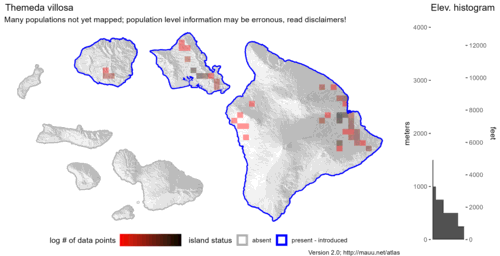

Inflorescence
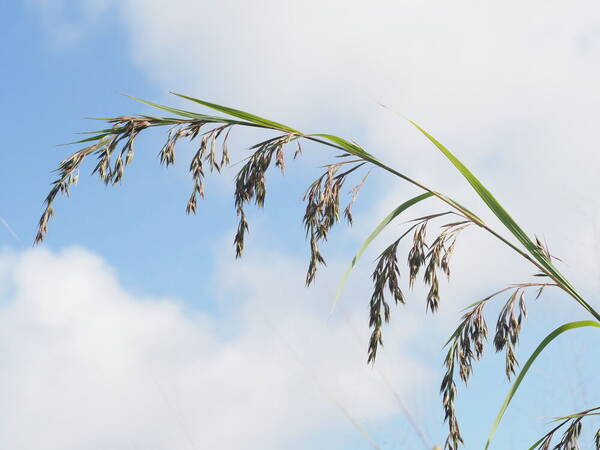
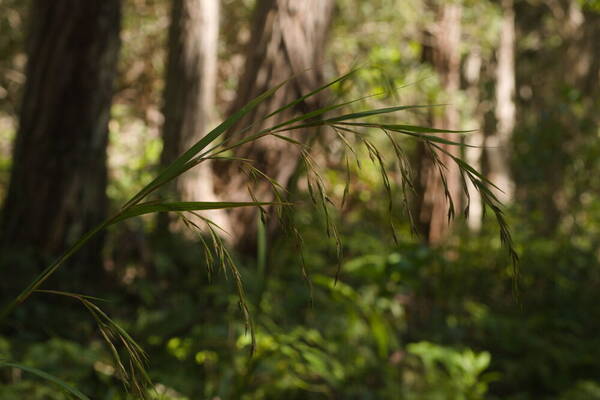
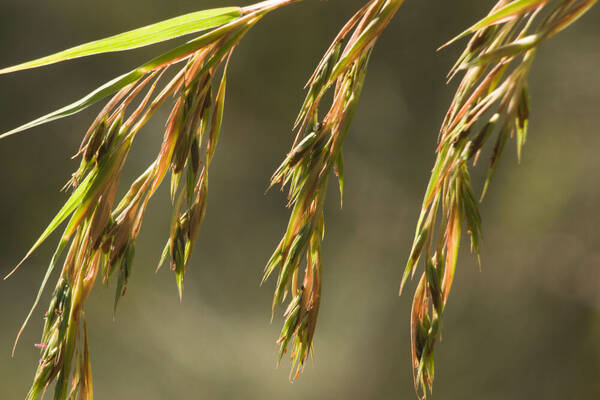
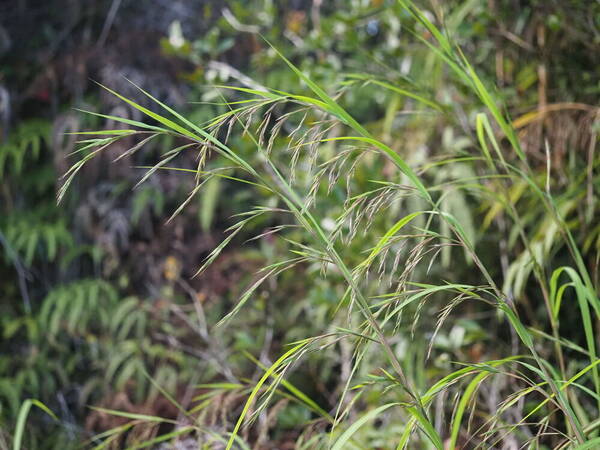
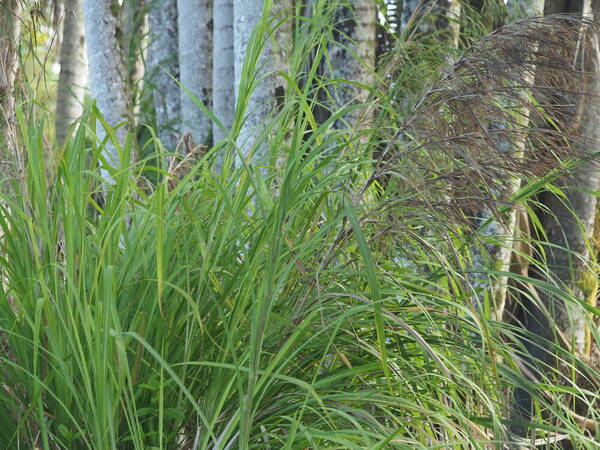
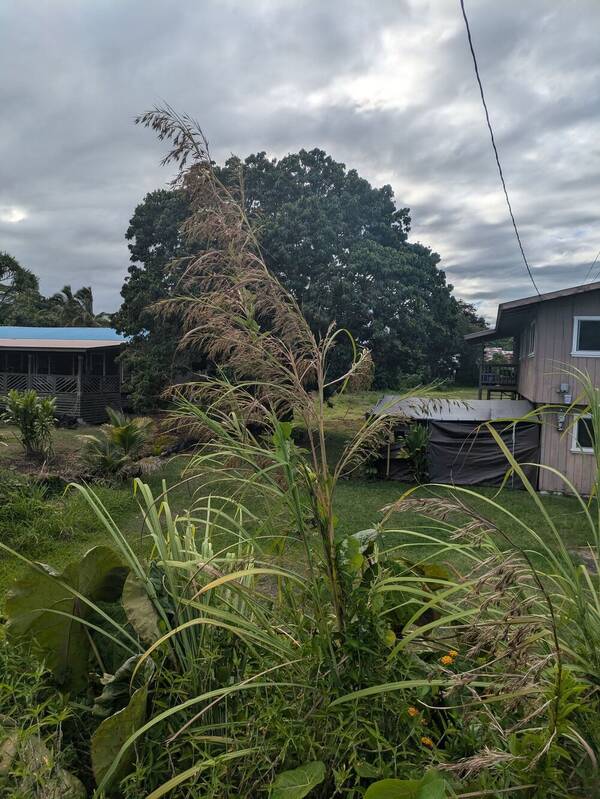
Plant
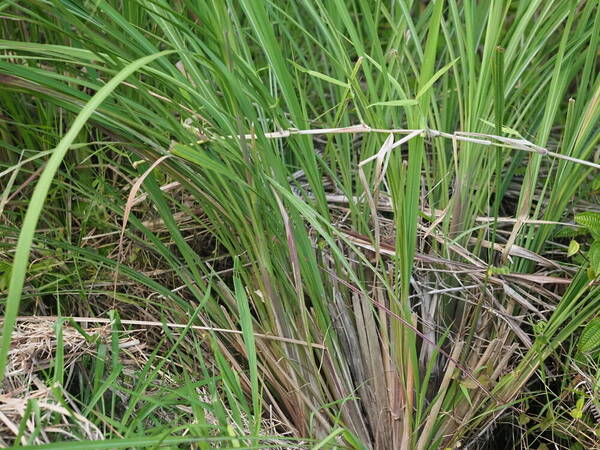
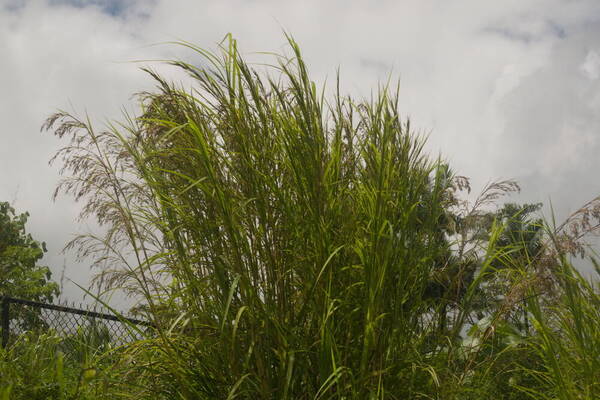

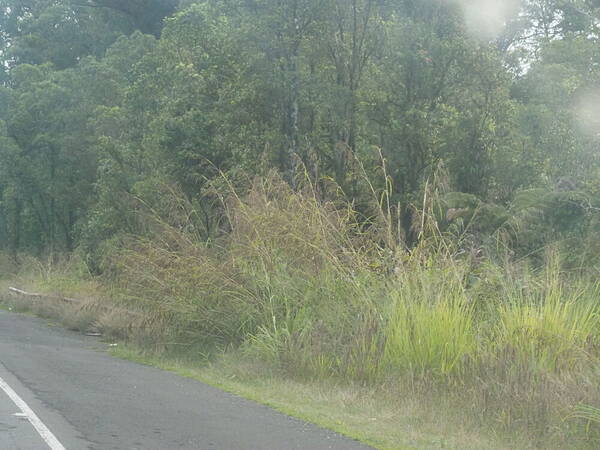
Habit
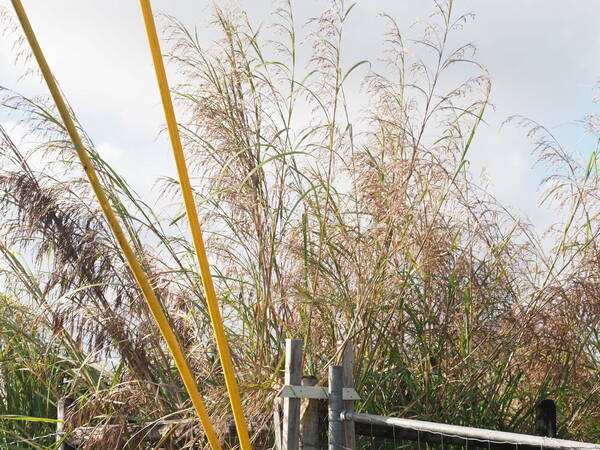
Spikelets
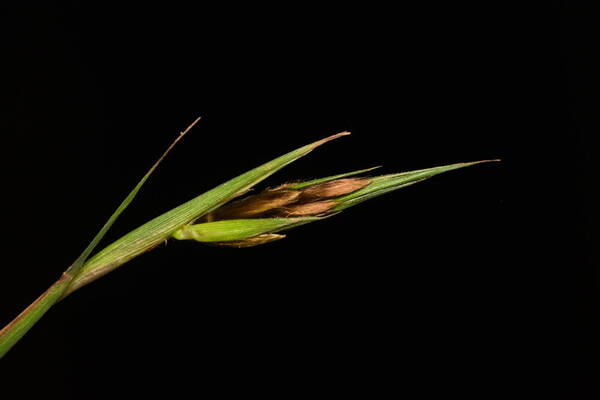
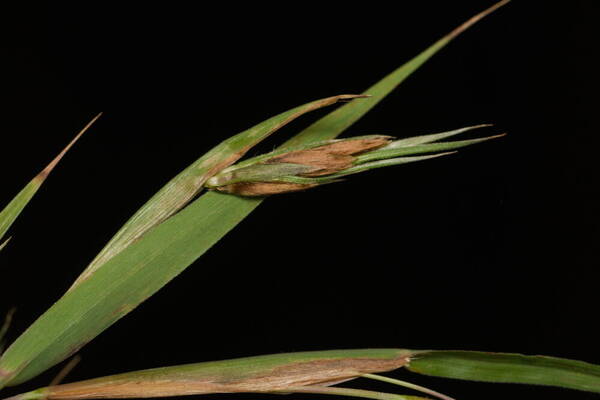
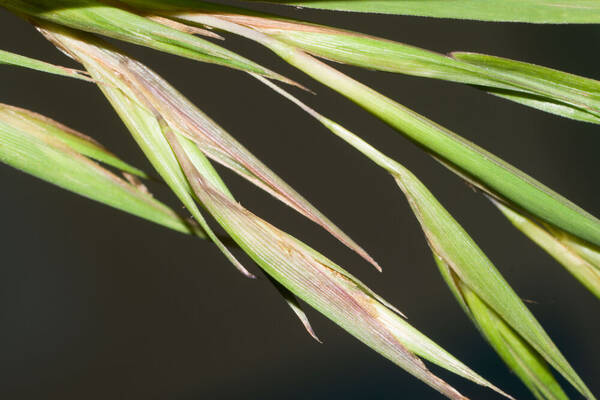
Culm base
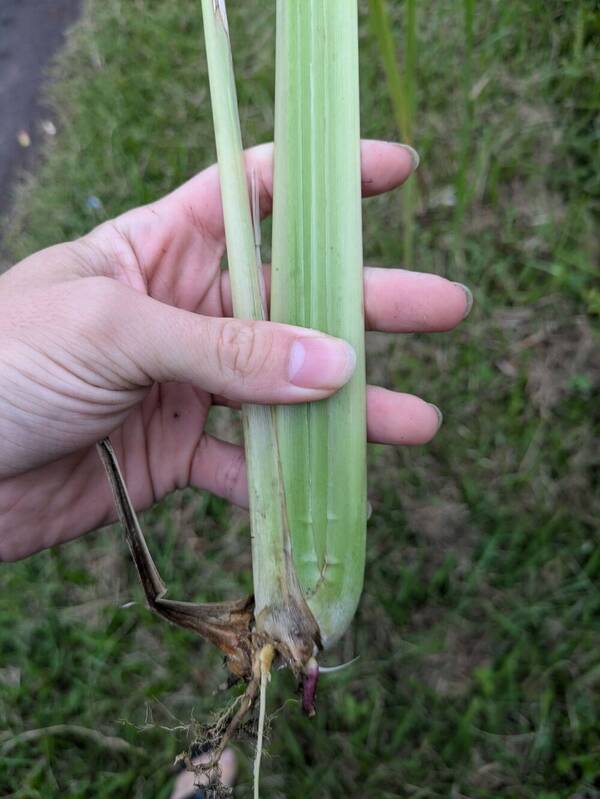
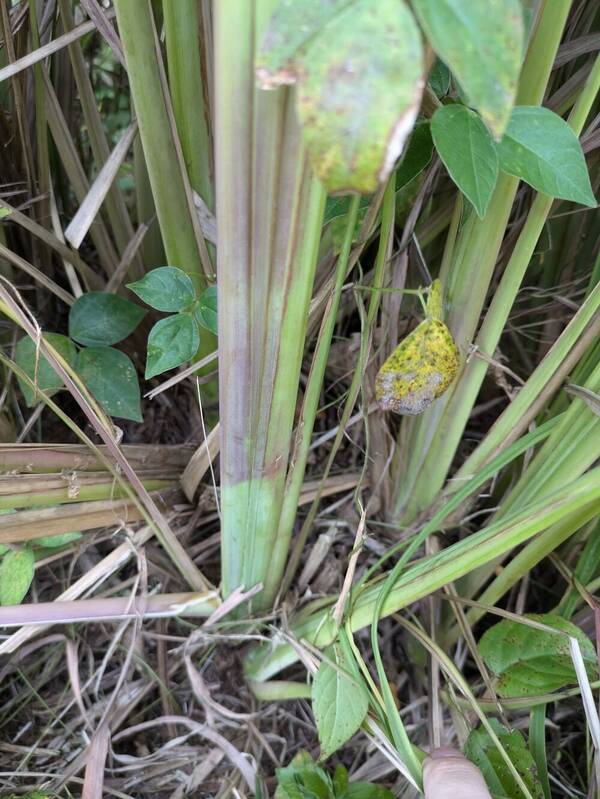
Description
Habit: Perennial. Basal innovations flabellate. Culms robust; 200-300 cm long. Ligule a ciliolate membrane. Leaf-blades 50-100 cm long; 6-12 mm wide. Inflorescences: Synflorescence compound; paniculate; 30-60 cm long; dense. Inflorescence composed of racemes; terminal and axillary; subtended by a spatheole; embraced at base by subtending leaf. Spatheole lanceolate; 2.5-3.5 cm long; scarious; green; without tubercles; glabrous. Racemes 1; single; oblong; bearing few fertile spikelets; bearing 2-4 fertile spikelets on each. Rhachis fragile at the nodes. Rhachis internodes linear. Spikelets in pairs. Fertile spikelets sessile; 1 in the cluster. Companion sterile spikelets pedicelled; 1 in the cluster. Pedicels oblong; 0.5 mm long. Sterile Florets: Basal sterile spikelets well-developed; 4 in number; forming an involucre about the fertile; subsessile; lanceolate; 5-13 mm long; larger than fertile. Basal sterile spikelet glumes smooth, or tuberculate; pubescent; smooth on margins, or ciliate on margins (rufously); lower glume muticous. Companion sterile spikelets well-developed; male; lanceolate; 10-12 mm long; longer than fertile; separately deciduous. Companion sterile spikelet callus linear. Companion sterile spikelet glumes smooth; glabrous. Companion sterile spikelet lemmas 2; enclosed by glumes. Spikelets: Spikelets comprising 1 basal sterile florets; 1 fertile florets; without rhachilla extension. Spikelets elliptic; dorsally compressed; compressed slightly; 7-8 mm long; falling entire; deciduous with accessory branch structures. Spikelet callus cuneate; bearded; base acute; attached obliquely. Spikelet callus hairs red. Basal sterile spikelets well-developed; 4 in number; forming an involucre about the fertile; subsessile; lanceolate; 5-13 mm long; larger than fertile. Basal sterile spikelet glumes smooth, or tuberculate; pubescent; smooth on margins, or ciliate on margins (rufously); lower glume muticous. Companion sterile spikelets well-developed; male; lanceolate; 10-12 mm long; longer than fertile; separately deciduous. Companion sterile spikelet callus linear. Companion sterile spikelet glumes smooth; glabrous. Companion sterile spikelet lemmas 2; enclosed by glumes. Fertile Spikelets: Spikelets comprising 1 basal sterile florets; 1 fertile florets; without rhachilla extension. Spikelets elliptic; dorsally compressed; compressed slightly; 7-8 mm long; falling entire; deciduous with accessory branch structures. Spikelet callus cuneate; bearded; base acute; attached obliquely. Spikelet callus hairs red. Glumes: Glumes dissimilar; exceeding apex of florets; firmer than fertile lemma. Lower glume oblong; 1 length of spikelet; coriaceous; without keels. Lower glume surface pubescent. Lower glume hairs red. Lower glume apex obtuse. Upper glume oblong. Florets: Basal sterile florets barren; without significant palea. Lemma of lower sterile floret lanceolate; hyaline. Fertile lemma lanceolate; hyaline; without keel; 1 -veined. Lemma apex entire; muticous, or awned; 1 -awned. Principal lemma awn apical; geniculate; 0-10 mm long overall; with twisted column. Column of lemma awn puberulous. Palea absent or minute. Distribution: Africa: west tropical, west-central tropical, and east tropical. Asia-temperate: China. Asia-tropical: India, Indo-China, Malesia, and Papuasia. Pacific: north-central.
(Description source: Clayton, W.D., Vorontsova, M.S., Harman, K.T. and Williamson, H. (2006 onwards). GrassBase - The Online World Grass Flora. Available at https://powo.science.kew.org )
Robust perennials; culms tufted, stout, 20-40 dm tall, solid; culm base compressed, flabellate. Sheaths keeled, + compressed, margins overlapping, glabrous; ligule membranous, ciliate; blades up to 150 cm long, up to 20 mm wide, glabrous, midrib white, prominent, margins and nerves scabrous on upper surface, apex acuminate, base narrowed to the sheath. Inflorescences large, compound, drooping, paniculate, spathes 3-3.5 cm long, subtending a flattened rachis, apex pubescent, racemes of spikelet pairs at about the middle of the spathe; involucral and pedicellate spikelets reddish brown, similar in shape, narrowly fusiform, acuminate, 15-20 mm long, pedicels rufous pubescent; sessile spikelet with a callus ca. 2 mm long, densely pubescent with rufous hairs, first glume ovate, 10-nerved, the nerves reticulate toward apex, densely rufous pubescent between the nerves, apex acute, first lemma 1-nerved, apex acute; second lemma 1-nerved, hyaline, prolonged into a twisted pubescent awn up to 42 mm long, second palea lanceolate, nerveless, hyaline. Caryopsis reddish brown, fusiform, ca. 5 mm long. [2n= 32, 40.]
(Description source: O’Connor, P.J. 1990. Poaceae, pp. 1481–1604. In: Wagner W.L., Herbst D.R. & Sohmer S.H. (eds.)., Manual of the flowering plant of Hawaiʻi. Vol. 2. University of Hawaii Press & Bishop Museum Press, Honolulu )